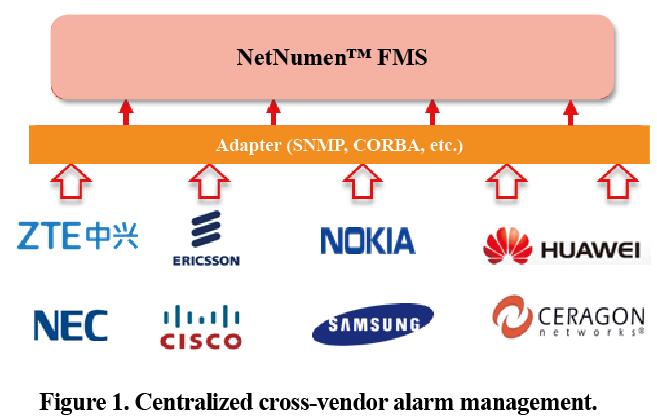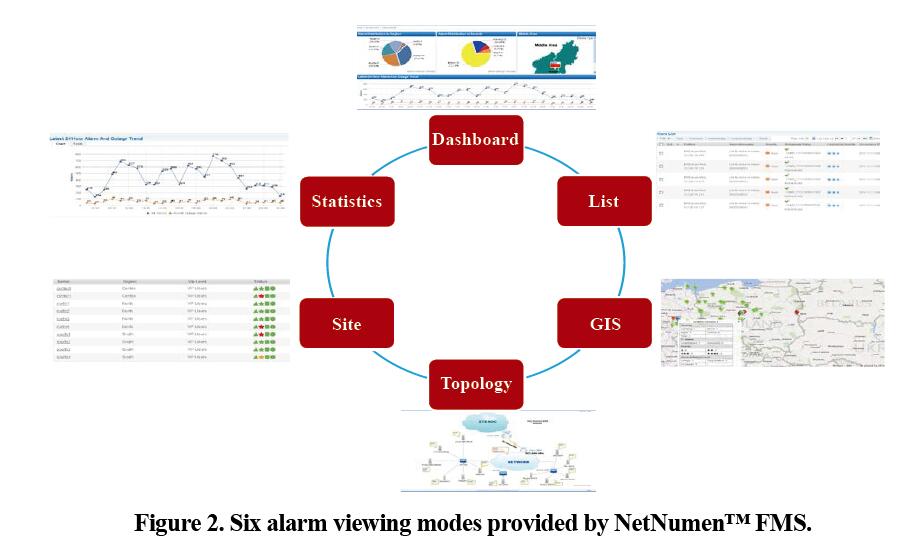NetNumen™ FMS: Improving Operational Efficiency
As telecom networks become increasingly sophisticated and new services emerge, the number and complexity of network alarms has increased. This has led to more difficult network operation and higher operational costs. Therefore, operators urgently need to shift from distributed management to centralized maintenance and management. Drawing on years of experience in equipment R&D and manufacturing, ZTE has launched NetNumen™ FMS―an integrated alarm management system to meet operator demands.
NetNumen™ FMS provides an open alarm management platform for operators to centrally manage alarms from different dedicated networks or different vendor equipment. It also helps operators improve the management of integrated alarms and operate their networks rapidly, flexibly, and cost-effectively.
Various Operation Scenarios
A typical telecom network consists of dedicated networks, such as wireless network, core network, transport network, and auxiliary power supply network, supplied by different vendors. When alarms occur on network devices, the element management systems (EMSs) of different vendors and different dedicated networks may report the alarms. It is difficult for an operator to centrally manage these alarms because they are distributed on different EMSs and vary greatly with network mode, vendor, and device type.
NetNumen™ FMS acts as an alarm management center for the entire network. It can obtain alarms from EMSs and PMSs, process these alarms, and then create trouble tickets that are sent to a trouble ticket system (TTS) for troubleshooting and tracing. This allows all faults to be properly handled end-to-end in a closed loop. NetNumen™ FMS can be used in the following scenarios:
● Operations engineers or administrators view alarms generated in certain regions, dedicated networks, sites, or other specified areas. They can view in different modes or at different angels according to their respective duties and purposes.
● Operations engineers handle the alarms within their administrative areas. They can acknowledge or un-acknowledge alarms, clear alarms, forward SMSs or emails, and assign trouble tickets, so that alarms are handled in a timely and effective way.
● System administrators configure and manage authorities, rules, views, and EMS access modes to ensure the FMS system operates smoothly and meets user needs.
Centralized Alarm Management
With ZTE's self-developed adapters, NetNumen™ FMS centrally manages alarms reported by devices of major vendors and that relate to mainstream technologies in the wireless, core, fixed, and transport networks as well as the auxiliary power supply. This eliminates the differences between equipment of different vendors and differences in network modes (Fig. 1).

Diverse Alarm Viewing Modes
NetNumen™ FMS provides six alarm viewing modes―list, dashboard, topology, statistics, site, and GIS―for different kinds of scenarios (Fig. 2). Engineers can choose the viewing mode according to application scenarios and their own duties. In list view, alarms are displayed in a list. Engineers can use this view to handle alarms. In dashboard view, multiple views are integrated on a single user interface in different layouts so that engineers can view the entire network from all angles. In site view, engineers can view the operations of certain sites.

With the user interfaces provided by NetNumen™ FMS, an engineer can easily customize the scope and mode of viewing.
Automatic Alarm Processing, Filtering, and Root Cause Analysis
NetNumen™ FMS provides automation policies for:
● automatic alarm handling. Automatic operations are defined by rules for clearing alarms, acknowledging alarms, assigning trouble tickets, and forwarding emails and SMSs. NetNumen™ FMS uses these rules to automatically handle alarms.
● alarm filtering. Alarm filtering rules such as flash, high frequency, and blocking are used to filter out alarms that are of no interest so that engineers can handle fewer alarms and focus only on important ones.
● root cause analysis (RCA). Troubleshooting experience is converted into automatic operation rules to help engineers rapidly find the root cause of an alarm. This improves troubleshooting efficiency and helps increase operational experience in a standardized way. NetNumen™ FMS provides an independent platform to run and manage the RCA rules. Users can analyze and locate the root cause of an alarm simply by configuring rules on the graphical interface.
Alarm Priority Policy
The priority of traditional operations is only based on the network itself. This may mean that alarms in low-value regions or with low service priorities are given a higher priority. However, an alarm priority policy should rapidly determine the importance of an alarm according to where it is generated and the extent to which it affects the service. The importance and priority of an alarm depends on two dimensions: alarm influence including outage, service degradation and no impact, and site influence including VIP users; governments, institutions, schools, hospitals; CBD; urban areas; rural areas; traffic routes; unknown areas; and sparsely-populated areas. The priority is indicated by a star rating of the above two dimensions. The more stars, the higher the priority. The alarm priority policy ensures that important alarms are handled first and operational resources are assigned properly.
NetNumen™ FMS is an effective tool for centralized alarm management. It supports devices from major vendors and for dedicated networks. It also has six alarm viewing modes for various operational scenarios. Its smart alarm filtering and RCA policies help an operator reduce the number of alarms to be handled and rapidly and precisely determine root causes. The alarm priority policy determines the importance and priority of an alarm according to affected alarm code and affected region. This ensures that important alarms are prioritized. NetNumen™ FMS has been commercially deployed for operators in Europe, Asia, and Africa and is helping them improve their operational efficiency.